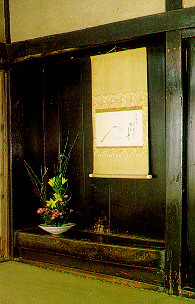DISPLAY
 In
relation, to the entertainment factor of daily life in shoin buildings,
many of the architectural elements were the result of the increased desire
to display personal possessions. For example, the decorative platform
or oshi-ita was originally no more than a portable wooden table or plank
placed under the hanging scrolls that decorated the walls of the palace
style rooms as a platform for decorative or religious objects. Between
the late fourteenth and early fifteenth centuries the oshi-ita began to
be a built-in element that is now called the tokonoma
alcove. This new permanence was partly in result to the continuing
interest in the acquisition and display of imported Chinese vertically
mounted scroll paintings. An accepted mode for arranging these objects
of art was established, thus permanent facilities for their display became
necessary. Another element illustrating shoin's role in the desire
to display are the chigai-dana (staggered shelves)
to display personal possessions like books and tea utensils. In keeping
with its origin as a tsukeshoin (desk alcove),
the shoin was used for the display of writing materials. In addition, chodaigamae
(decorative doors) were used as a display element unto itself and
was typically ornately painted. Thus, originating with the tokonoma alcove,
three elements evolved out of the function of display in order to create
what are considered the four formal display elements of Shoin Architecture.
In
relation, to the entertainment factor of daily life in shoin buildings,
many of the architectural elements were the result of the increased desire
to display personal possessions. For example, the decorative platform
or oshi-ita was originally no more than a portable wooden table or plank
placed under the hanging scrolls that decorated the walls of the palace
style rooms as a platform for decorative or religious objects. Between
the late fourteenth and early fifteenth centuries the oshi-ita began to
be a built-in element that is now called the tokonoma
alcove. This new permanence was partly in result to the continuing
interest in the acquisition and display of imported Chinese vertically
mounted scroll paintings. An accepted mode for arranging these objects
of art was established, thus permanent facilities for their display became
necessary. Another element illustrating shoin's role in the desire
to display are the chigai-dana (staggered shelves)
to display personal possessions like books and tea utensils. In keeping
with its origin as a tsukeshoin (desk alcove),
the shoin was used for the display of writing materials. In addition, chodaigamae
(decorative doors) were used as a display element unto itself and
was typically ornately painted. Thus, originating with the tokonoma alcove,
three elements evolved out of the function of display in order to create
what are considered the four formal display elements of Shoin Architecture.
[Main Page]
[Development]
[Functions]
[Features]
 In
relation, to the entertainment factor of daily life in shoin buildings,
many of the architectural elements were the result of the increased desire
to display personal possessions. For example, the decorative platform
or oshi-ita was originally no more than a portable wooden table or plank
placed under the hanging scrolls that decorated the walls of the palace
style rooms as a platform for decorative or religious objects. Between
the late fourteenth and early fifteenth centuries the oshi-ita began to
be a built-in element that is now called the tokonoma
alcove. This new permanence was partly in result to the continuing
interest in the acquisition and display of imported Chinese vertically
mounted scroll paintings. An accepted mode for arranging these objects
of art was established, thus permanent facilities for their display became
necessary. Another element illustrating shoin's role in the desire
to display are the chigai-dana (staggered shelves)
to display personal possessions like books and tea utensils. In keeping
with its origin as a tsukeshoin (desk alcove),
the shoin was used for the display of writing materials. In addition, chodaigamae
(decorative doors) were used as a display element unto itself and
was typically ornately painted. Thus, originating with the tokonoma alcove,
three elements evolved out of the function of display in order to create
what are considered the four formal display elements of Shoin Architecture.
In
relation, to the entertainment factor of daily life in shoin buildings,
many of the architectural elements were the result of the increased desire
to display personal possessions. For example, the decorative platform
or oshi-ita was originally no more than a portable wooden table or plank
placed under the hanging scrolls that decorated the walls of the palace
style rooms as a platform for decorative or religious objects. Between
the late fourteenth and early fifteenth centuries the oshi-ita began to
be a built-in element that is now called the tokonoma
alcove. This new permanence was partly in result to the continuing
interest in the acquisition and display of imported Chinese vertically
mounted scroll paintings. An accepted mode for arranging these objects
of art was established, thus permanent facilities for their display became
necessary. Another element illustrating shoin's role in the desire
to display are the chigai-dana (staggered shelves)
to display personal possessions like books and tea utensils. In keeping
with its origin as a tsukeshoin (desk alcove),
the shoin was used for the display of writing materials. In addition, chodaigamae
(decorative doors) were used as a display element unto itself and
was typically ornately painted. Thus, originating with the tokonoma alcove,
three elements evolved out of the function of display in order to create
what are considered the four formal display elements of Shoin Architecture.